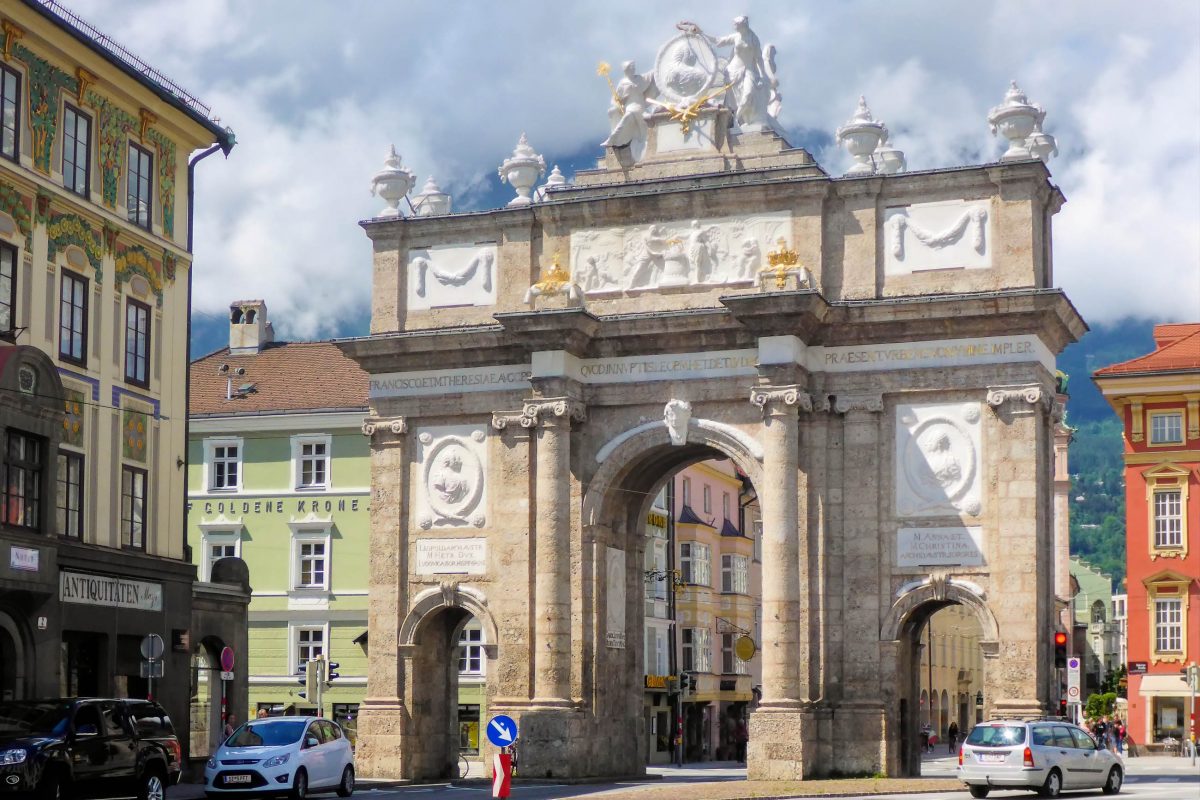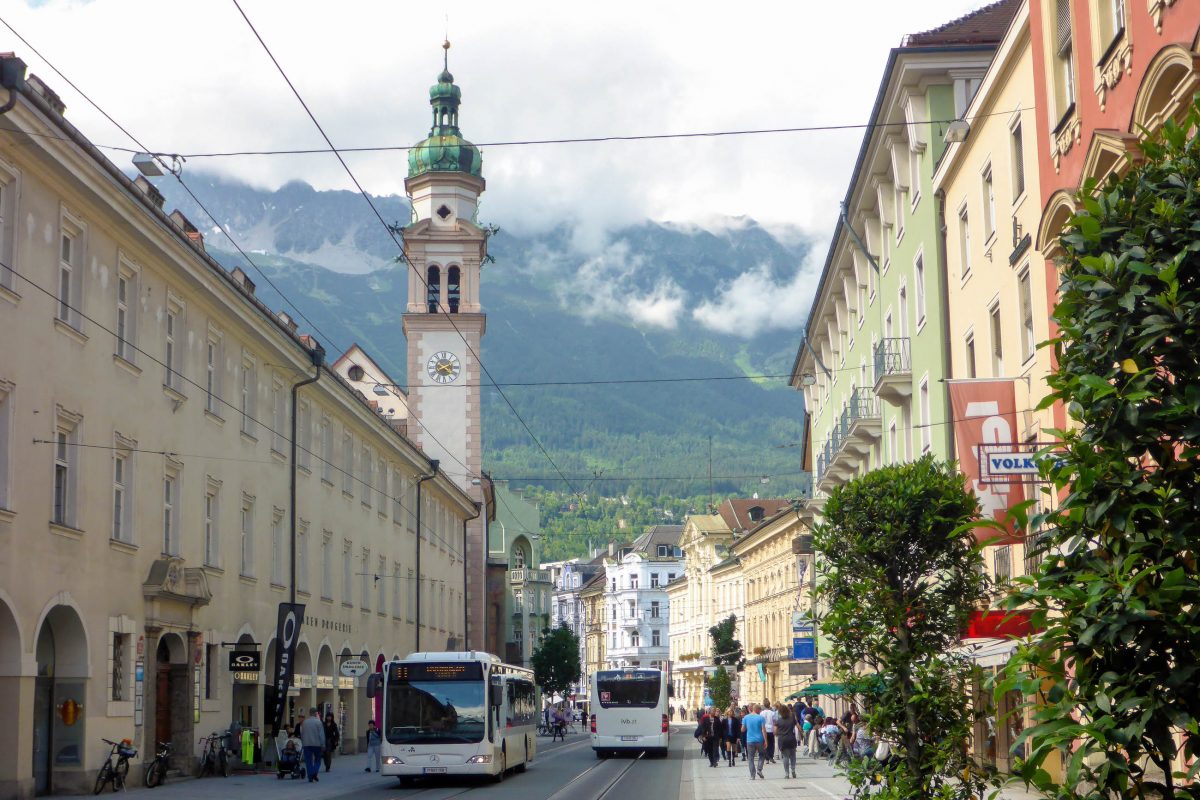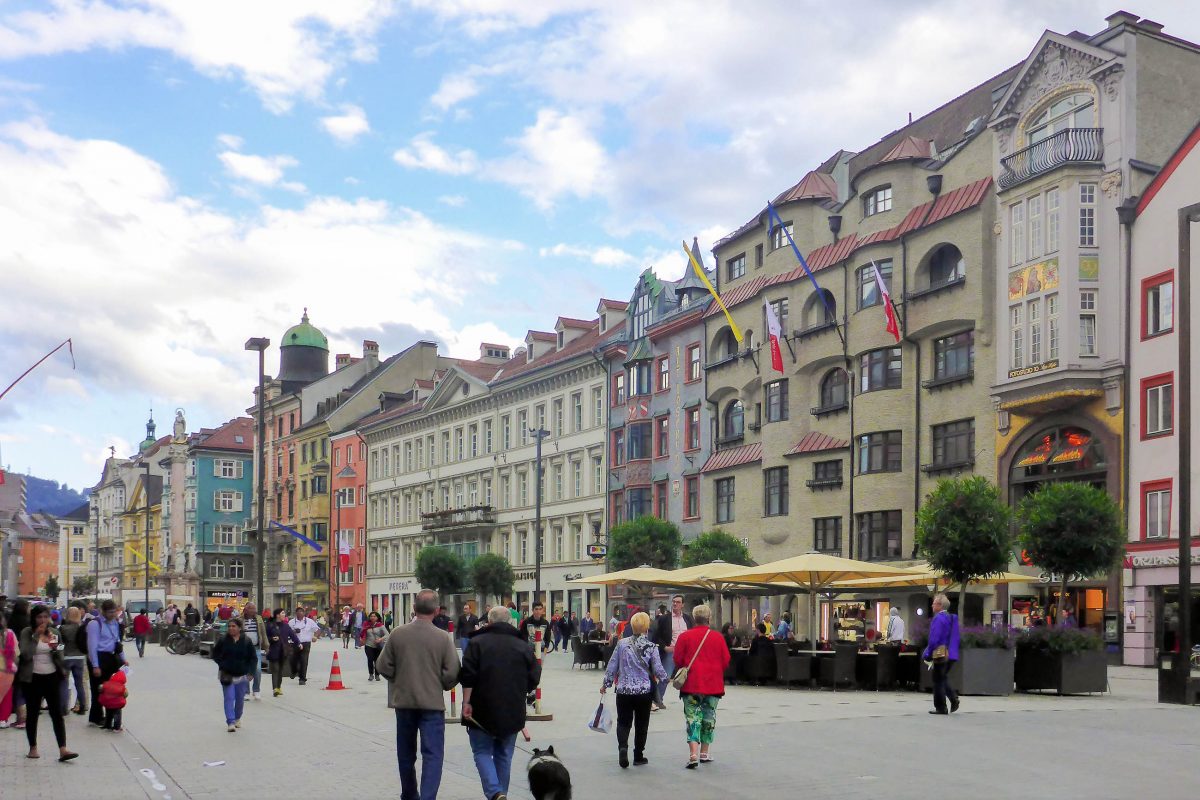Die Maria-Theresien-Straße in der Altstadt von Innsbruck wurde im Zuge der Stadterweiterung im 13. Jahrhundert angelegt und ist heute eine der sechs bedeutendsten Einkaufsstraßen von Österreich.
Die breit angelegte Maria-Theresien-Straße gehört zu unseren Top 10 Sehenswürdigkeiten in der Altstadt von Innsbruck. Sie führt von der Triumphpforte bis zum ehemaligen Stadtgraben in Richtung Goldenes Dachl. Innsbrucks Maria-Theresien-Straße ist nicht nur die meistfrequentierte Straße der Stadt, sondern auch eine der sechs bedeutendsten Einkaufsstraßen von Österreich.
BILDER: Maria Theresien Straße in Innsbruck
Fotogalerie: Maria-Theresien-Straße in Innsbruck
Sehenswürdigkeiten auf der Innsbrucker Maria-Theresien-Straße
Die heutige Flaniermeile wurde im Zuge der Stadterweiterung im 13. Jahrhundert angelegt. Damals Teil der Neustadt ist sie seit 1873 nach Kaiserin Maria Theresia benannt. Den imperialen Straßenzug säumen prächtige Barockfassaden, die gemeinsam mit modernen Geschäftslokalen, Cafés und Restaurants einen attraktiven Mix aus Alt und Neu bilden.
Ab der Anichstraße ist die Maria-Theresien-Straße Fußgängerzone und wird für öffentliche Veranstaltungen, Aufmärsche und Kundgebungen verwendet. Veranstaltungen wie der Christkindlmarkt in der Adventszeit oder Public Viewing bei großen Kultur- und Sportereignissen ziehen zu den täglich 30.000 noch einmal mehr Besucher an.
Nach knapp 500 Metern mündet die Maria-Theresien-Straße in die Herzog-Friedrich-Straße die direkt zum Goldenen Dachl führt.
Triumphpforte

Die Triumphpforte befindet sich am südlichen Ende der Maria-Theresien-Straße. Das Südtor der einstigen Stadtmauer ist heute ein idealer Ausgangspunkt für Sightseeing in der Innsbrucker Altstadt.
Das steinerne Portal wurde 1765 im Auftrag von Kaiserin Maria Theresia zu Ehren der Hochzeit von Erzherzog Leopold mit Maria Ludovica errichtet. Der Bild- und Figurenschmuck aus Sterzinger Marmor wurde von Johann Baptist Hagenauer entworfen, der auch die Mariensäule vor dem Salzburger Dom und einige Skulpturen an der Gloriette im Schlosspark von Schönbrunn in Wien schuf.
Tor zwischen Triumph und Trauer

Die Heirat des zweiten Sohnes von Kaiserin Maria Theresia und der Prinzessin von Spanien am 5. August 1965 wurde allerdings von einer Tragödie überschattet. Nicht einmal zwei Wochen später, am 17. August 1965, starb Franz Stephan von Lothringen, Ehemann Maria Theresias und Vater des Bräutigams, völlig überraschend an einem Schlaganfall.
Sein Sterbezimmer in der Hofburg von Innsbruck, ließ Maria Theresia in eine Kapelle umfunktionieren, in der die Stiftsdamen der Hofburg für den verstorbenen Kaiser beten konnten.
Dementsprechend wurde auch die Gestaltung der Triumphpforte an Liebe und Tod im Habsburgerreich angepasst. Die Südseite der Triumphpforte stellt Motive zu Ehren des Brautpaares dar, während die Marmorreliefs der Nordseite den plötzlichen Tod des Kaisers thematisieren.
Die Porträtmedaillons an beiden Seiten zeigen Kaiserin Maria Theresia und ihren Gemahl Franz Stephan mit Lorbeerkranz, das junge Hochzeitspaar Leopold und Maria Ludovica und das Herzogenpaar Karl und Karoline von Lothringen, Verwandte des Kaisers.
Mit dem österreichischen Erzherzogshut mit dem Orden vom Goldenen Vlies und der böhmischen Wenzelskrone mit dem ungarischen Stephansorden sind auch wichtige Statussymbole der Habsburger auf der Triumphpforte vertreten.
Servitenkirche

Die Servitenkirche zum Hl. Josef mit angeschlossenem Kloster wurde von der Witwe Erzherzog Ferdinands gestiftet, 1616 gegründet und 10 Jahre später errichtet. Nach dem Zweiten Weltkrieg wurde die Kirche wiederaufgebaut und beherbergt bis heute den Serviten-Orden.
Palais Lodron (Nr. 7)
Als 1620 ein Brand verheerende Schäden unter den Holzhäusern anrichtete, ordnete die Regierung Steinhäuser an, was die Geburtsstunde der prächtigen Palais auf der Maria-Theresien-Straße einläutete. Das Rokoko-Palais des Grafen Lodron aus dem Jahr 1749 ist das erste, welches man nach der Triumphpforte passiert.
Gasthaus Alt-Innsprugg (Nr. 16)
Das aus dem 15. Jahrhundert stammende Haus wurde 1906 umgebaut und ist aufgrund seiner Holzschnitzereien an der Fassade sehenswert. Unter anderem sind darauf die Kopien zweier Statuen aus der Hofkirche zu sehen.
Neues Rathaus und Rathausgalerien (Nr. 18)

Das Neue Rathaus ist in drei Barockbauten des ehemaligen Palais Künigl untergebracht. Sie wurden im frühen 18. Jahrhundert von Gumpp errichtet und beherbergten einst das erste Hotel Innsbrucks.
2002 erfolgte eine großzügige Erweiterung mit einem modernen Glaskomplex, der neben der Stadtverwaltung auch Platz für ein Kongresshotel und die Einkaufspassage „Rathausgalerien“ bietet. Von dessen Aufzugsturm bietet eine Aussichtsplattform, ebenso wie der Dachgarten des Hotels, einen herrlichen Rundblick über die Altstadt von Innsbruck.
Palais Trapp (Nr. 38)
Das Palais Trapp stammt aus dem 17. Jahrhundert und wurde ab 1700 von Johann Martin Gumpp dem Älteren errichtet, dessen Baumeisterfamilie damals einen Großteil der regionalen Prachtbauten entwarf. Bis heute ist das Palais im Besitz des Grafen Trapp.
Palais Troyer-Spaur (Nr. 39)
Gemeinsam mit dem Palais Fugger-Taxis war das um 1680 errichtete Palais Troyer-Spaur einer der ersten Prachtbauten, die von Johann Martin Gumpp dem Älteren auf der Maria-Theresien-Straße errichtet wurden.
Annasäule

Die weithin sichtbare Annasäule wurde 1706 errichtet, um den Abzug der bayrischen Truppen zu feiern, der 1703 am 26. Juli, dem Annatag, geschah. Gekrönt von der Jungfrau Maria ist auch ihre Mutter Anna im Norden der Säule als Marmorfigur vertreten.
Die übrigen drei Heiligen an der Annasäule sind der Hl. Kassian im Westen, der Hl. Vigilius im Osten und der Hl. Georg im Süden, unverkennbar mit Drache und Lanze.
Einst plätscherten zu Füßen der prächtigen Säule aus rotem Marmor auch der Josefs- und Joachimsbrunnen. Letzterer ist heute im Waltherpark am anderen Ufer des Inn zu sehen.
Altes Landhaus (Nr. 43)

Das Alte Landhaus von Georg Anton Gumpp gilt als einer der prächtigsten Barockbauten Innsbrucks und beherbergt in seinen prunkvollen Räumlichkeiten den Tiroler Landtag.
Monumentale Prunkstiegen, stuck- und marmorverzierte Säle, geschnitzte Türen und meisterhafte Wand- und Deckenfresken machen das Alte Landhaus auch einen Besuch von innen wert. Hier sind übrigens die Originale der Heiligenfiguren vom Sockel der Annasäule zu sehen, die 2009 durch Kopien ersetzt wurden.
Palais Fugger-Taxis (Nr. 45)
Für Graf Fugger von Johann Martin Gumpp dem Älteren um 1680 errichtet, fungierte die barocke Palastanlage von 1784 bis 1905 als Postgebäude unter dem Grafen Thurn und Taxis, bevor es vom Land Tirol erworben wurde.
Spitalskirche
Die Spitalskirche erinnert heute noch an das Heilig-Geist-Spital, das im Jahr 1315 gegründet wurde. Wie damals üblich wurde das Krankenhaus außerhalb der Stadtmauern errichtet, die damals etwa auf Höhe des Alten Landhauses verliefen. Der heutige Bau wurde 1700 von Johann Martin Gumpp dem Älteren errichtet.





